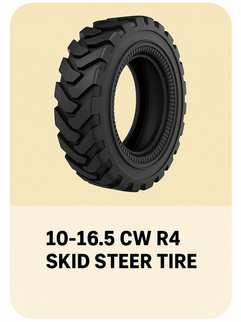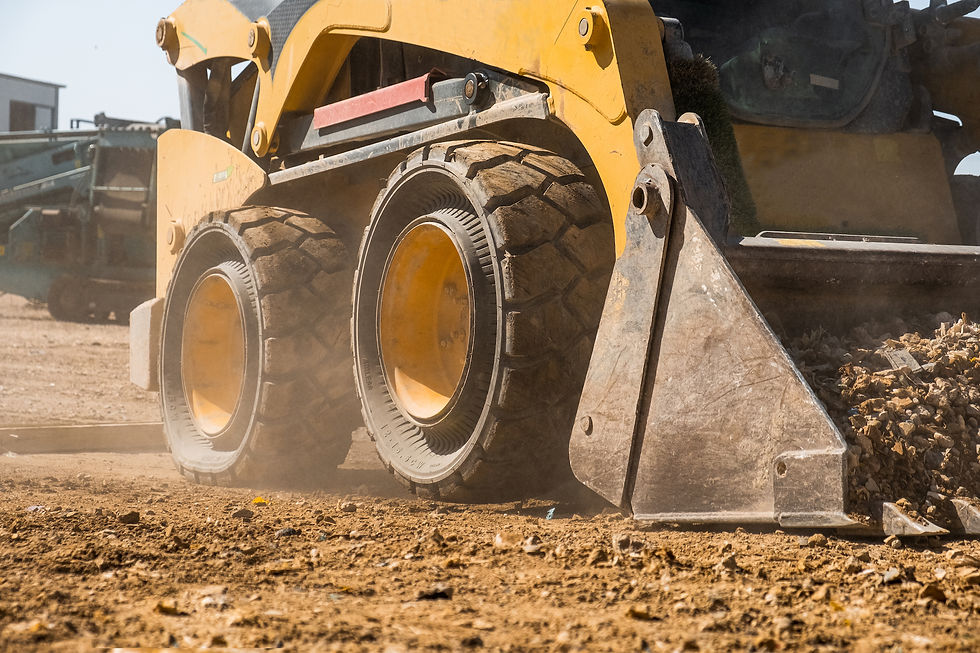Airless Skid Steer Tires: Brief Guide to Flat-Free Solutions
- Galileo Wheel

- Apr 24
- 6 min read
Updated: Apr 27
If you've ever had to stop work because of a flat tire on your skid steer, you know the frustration all too well. That nail lurking in the debris, that piece of rebar sticking out of the rubble – they're your equipment's worst enemies. But what if there was a way to make flat tires a thing of the past? Welcome to the world of airless skid steer tires, the game-changing solution that's keeping construction and industrial operations running smoothly.
The skid steer loader market isn't small potatoes either – we're talking about a $9.4 billion industry that's growing at over 4% annually. With major players like Bobcat, Caterpillar, and John Deere pushing the boundaries of what these machines can do, tire technology had to evolve. And boy, has it ever.

What Are Airless Skid Steer Tires?
Think of airless tires as the tank-like cousins of your regular tires. Instead of relying on air pressure to keep their shape and do their job, they manage to do it in a different way. No air means no flats – it's that simple.
These air free tires come in different flavors:
Solid rubber tires - the simplest and most common type of airless tires. While they can't be punctured, they have significant drawbacks, with the main one being the lack of shock absorption, which is particularly critical considering that skid loaders don't have their own suspension system
Polyurethane-filled hybrids - regular tires that are filled with a special mixture. They become heavy and lack adequate maneuverability
Clever segmented designs that give you the best of both worlds and more, such as SkidCups, but more on that later
The beauty of this technology? When that nail hits your tire, you just keep on working. No hissing sound, no sinking feeling, no lost productivity. And considering that the industry produces around 800,000 units of 10-16.5 tires and 960,000 units of 12-16.5 tires annually, that's a lot of potential flats avoided.
Key Benefits of Using Airless Tires on Skid Steers
Let's get real about why operators are switching to airless tires. This isn't just about avoiding flats – it's about transforming how you work.
Extended Lifespan and Durability
Here's what most people don't realize: those seemingly expensive airless tires often outlast several sets of traditional tires. The math is simple – pay more upfront, replace less often.
Quality airless tires typically run for 2,000-3,000 operating hours, while your average pneumatic tire might give you 800-1,000 hours if you're lucky. Sure, you might wince at the initial price tag, but when you're still running the same tires two years later while your buddy has replaced his pneumatics three times, you'll be the one smiling.
Low Maintenance Requirements
Remember the last time you checked your tire pressure? With airless tires, that daily ritual becomes ancient history. No more:
Morning pressure checks
Emergency repair kits
Sidewall repairs
"Is that tire looking low?" moments
Your maintenance crew will thank you, and your accountant will love the reduced labor costs.
Puncture-Proof and Flat-Free Performance
This is the headline feature. Demolition sites, scrap yards, construction zones – these places eat regular tires for breakfast. Nails, glass, metal shards – they're everywhere. With non air tires, these hazards become non-issues.
Picture this: you're demolishing a building, debris everywhere. Your operator hits a piece of rebar that would normally mean a 45-minute tire change. With airless tires? They don't even notice. That's money in the bank. Some contractors report losing 2-3 hours per machine per week to tire issues – that's productivity you get back instantly with airless technology.
Ideal for Harsh and Rugged Terrain
Ever tried running regular tires in a gravel pit? It's like sending a kid with new shoes into a mud puddle – disaster waiting to happen. Airless tires thrive in these conditions. They grip, they resist cuts, they power through mud, and they keep you moving when others are stuck changing flats.
Types of Airless Skid Steer Tires Available
Not all airless tires are created equal. Let's break down your options so you can make the smart choice.
Solid Rubber Tires
These are your basic workhorses – all rubber, all the time. They typically weigh in at 180-220 pounds per tire with a hardness rating of 65-70 Shore A.

The Good:
Practically indestructible
Cheapest airless option (starting around $600 per tire)
Zero maintenance
Lifespan of 1,500-2,000 hours
The Not-So-Good:
Rides like a shopping cart with a bad wheel
Can rattle your machine (and operator) to pieces
Heavy as heck (20% increase in rolling resistance)
Polyurethane-Filled Tires
Take a regular tire, fill it with liquid polyurethane, wait for it to cure – boom, instant airless tire. These typically use 35-40 pounds of polyurethane per tire.

The Good:
Rides better than solid rubber (about 70% shock absorption compared to pneumatic)
Good middle-ground solution
2,000-2,500 hour lifespan
The Not-So-Good:
Still pretty heavy (160-190 pounds per tire)
Expensive
Not as comfy as segmented designs
Can be a pain to install
Segmented Tire Designs
This is where the magic happens. Companies like Galileo have figured out how to make airless tires that actually flex and absorb shock.

The Good:
Rides almost like pneumatic tires or even better (85-90% shock absorption)
Saves your machine from vibration damage
Keeps operators happy
Actually improves traction
Longest lifespan
The Not-So-Good:
It is not cheap, more expensive than a solid one, but it’s definitely worth it
How to Choose the Right Airless Tires for Your Skid Steer
Don't just buy the first airless tires you see. Here's how to pick winners.
Consider the Terrain You Work On
Be honest about where you work:
Construction sites with debris? Get aggressive treads
Smooth warehouse floors? Go for smooth patterns
Mix of everything? All-terrain designs are your friend
Remember, tread pattern affects more than just traction – it impacts ride quality and wear rate too.
Think About Load Capacity and Machine Weight
This isn't the place to cut corners. If your skid steer weighs 8,000 pounds, don't put tires rated for 6,000 pounds on it. Check your machine's specs, add the weight of your heaviest attachment, then add a safety margin. Some airless tires can handle up to 12,000 pounds per tire – make sure you're in the right ballpark.
Match Tire Type to Frequency and Intensity of Use
Running two shifts in a scrap yard? Spring for the good stuff – segmented designs will save your machine and your operators. Weekend warrior doing light landscaping? Basic tires might do the trick.
Heavy use means more stress on equipment, and better tires can actually reduce wear on your skid steer's components.
Evaluate Long-Term Costs, Not Just Upfront Price
Do the math:
How many pneumatic tires do you go through yearly?
What's your average downtime cost per flat?
How much do you spend on tire maintenance?
Add it all up, then compare to the airless option. The results might surprise you. Many operators find airless tires pay for themselves more quickly than you can imagine.
Check Compatibility with Your Skid Steer Model
Not all tires fit all machines. Check:
Bolt patterns
Hub specifications
Clearance requirements
Your dealer's recommendations
And again - machine weight
Don't assume – measure twice, buy once. Some newer skid steers come with tracks as standard because traditional tires couldn't handle the demands, but airless options are changing that equation.
Top Brands and Models on the Market
Let's talk about who's making waves in the airless tire game.
Michelin X Tweel The big dog in the yard. These poly-resin spoke tires cost a pretty penny ($1,200 for 10-16.5), but they've got the name recognition. They feature a unique spoke design that's proven itself in tough conditions, though even with the latest generation there are complaints that the spokes wear out fairly quickly and the tire needs to be replaced.
Galileo SkidCup A newcomer that's stealing market share. Priced below Michelin ($990 for 10-16.5) with performance that often beats it. Their CupWheel design is winning fans, especially among operators who value ride comfort and owners who aren't eager to repair their machines due to impact damage.
McLaren Nu-Air Pricey ($1100 for 10-16.5) "solid cushion" tires with a solid reputation. Good for extreme conditions. Pricing varies by application, but they're known for durability in the toughest environments.
Camso SKS Solid Reliable workhorses for general construction. Won't break the bank. These offer good value for operators who need basic solid tire performance.

Bobcat at Work on Galileo Wheel Airless Skid Steer Tires
Conclusion
Here's the bottom line: if downtime is killing your productivity, if tire maintenance is eating your budget, or if you're just tired of dealing with flats, airless tires deserve a serious look.
Yes, they cost more upfront. But when you factor in the reduced downtime, lower maintenance costs, and longer lifespan, they pay for themselves quickly. Plus, there's something to be said for the peace of mind that comes from knowing a nail can't ruin your day.
The construction world is changing, and airless tires are leading the charge. Whether you're running a fleet of skid steers or just looking to upgrade your single machine, these tire without air solutions might be exactly what you need to take your operation to the next level.
With the skid steer loader market growing and operators demanding more from their equipment, airless technology is positioned to become the new standard. As more manufacturers enter the space and competition drives innovation, we're likely to see even better performance and more competitive pricing in the years ahead.
Remember, the best tire is the one that keeps you working. And in that department, airless tires are hard to beat. When you consider that a single flat can cost $500-$1,000 in lost productivity and repairs, the investment in airless technology starts looking less like a luxury and more like smart business.










Comments